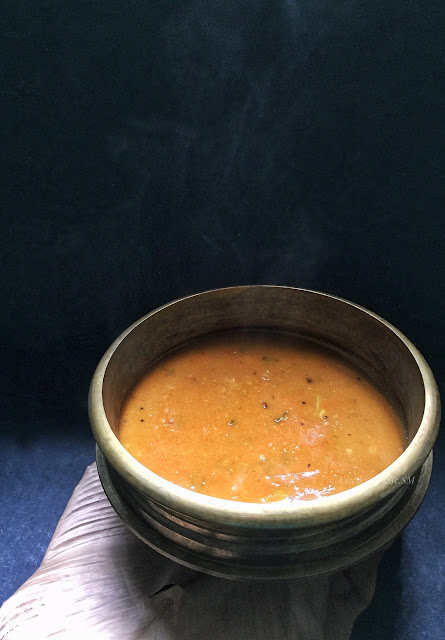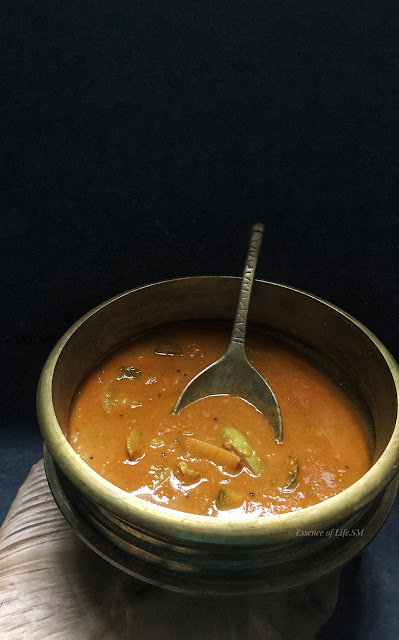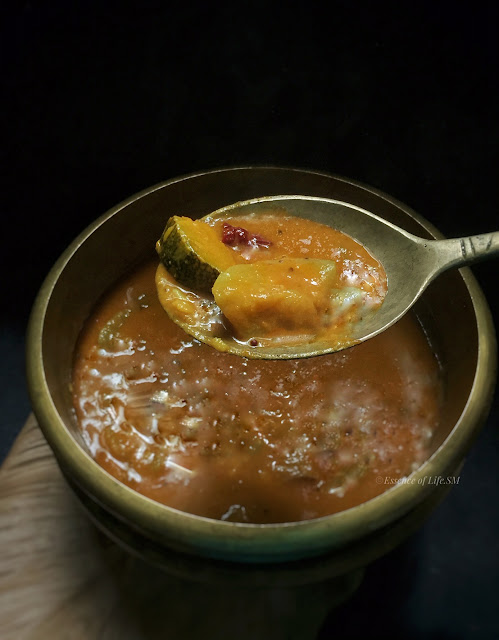KERALA SADHYA SAMBAR
 |
| KERALA SADHYA SAMBAR |
സാമ്പാർ ഇല്ലാതെ എന്തു സദ്യ ?!!! What's a Sadhya without a Sambar?!!!
Though the provenance of the quintessential Tamilian Sambar was a Maratha creation, it can be found in almost every South Indian Cuisine & also in Udupi Cuisine with regional variations. Palaghat Iyers, who migrated to Kerala from Tamil Nadu would have brought the tradition of Sambar to Kerala Cuisine. And what made their Sambar distinct is the addition of locally available ingredients. Obviously, we all know if it is Kerala then it should be Coconut & Coconut Oil. Most of the Kerala Sambar uses Coconut in the recipe and the Sambar recipes without Coconut also find its unique mark as all the seasoning are done in Coconut Oil.
When it comes to Sadhya Sambar, it is one major attraction in a Sadhya Vattom. One of the main Ozhichu Curry or Curry served along with Rice. Though Curries like Paruppu, Parippu Curry, Moru Curry, Pulissery, Rasam are also served, Sambar is a must and unavoidable curry when it comes to Kerala Sadhya or Tamil Style Virundhu. Well, what makes a Sadhya Sambar special is that it should be flavourful & aromatic and should stand alone in midst of other long listed dishes in a Sadhya Vattom.
Some even make it simpler by preparing it with Sambar Powder. But traditionally Sadhya Sambar is prepared in an elaborate way. Though the basic ingredients of a Sambar come under a broad outline - Tuvar Dhal & Tamarind based Curry. But other ingredients vary according to the cook and region. During family Weddings in Kerala, I have seen cooks making it with freshly roasted and ground Sambar Masala and the Vegetables used for a Sadhya Sambar has its unique style. Local Vegetables like Ash Gourd, Pumpkin, Drumstick, Brinjal (Eggplant), Okra (Lady's Finger), Elephant Foot Yam, Raw Banana, Yellow Cucumber (Vellarikka) & Tomatoes are added in it. Usually, Shallots or Ulli are not used while cooking for Sadhya. But Ulli/Shallot Sambar is one authentic Sambar commonly found in Kerala & Tamil Cuisine.
Sambar is always Sambar, but it acquires the flavour of the spices, coconut & the vegetables added into it to make it more special indeed. Though this recipe is similar to Varutharacha Sambar, the uniqueness of Kerala Sadhya Sambar comes with the addition of a few other spices & usage of traditional Vegetables and above all tempering the seasoning in Coconut Oil. Some even keep Sadhya Sambar simple and prepare it in a quick & easy method, as there would be a long list of dishes to be prepared for a Sadhya Vattom. But this Sadhya Sambar recipe is a traditional method prepared commonly by cooks in Kerala for a Sadhya.
For more SADHYA RECIPES, click here...
Cuisine - Kerala (South India)
Course - Curry, Side Dish
Spice Level - Medium
Difficulty - Medium
Serves - 3- 4
Author - SM
Preparation Time - 15 -20 Minutes
Cooking Time - 25 - 30 Minutes
For more recipes from GODS OWN COUNTRY - KERALA click here...
HOW TO MAKE KERALA SADHYA SAMBAR
 |
| KERALA SADHYA SAMBAR |
INGREDIENTS :
For Dhal:
Tuvar Dhal(Pigeon Pea) - 1/2 CupTurmeric Powder - a Pinch
Coconut Oil/Ghee - 1 Teaspoon (Optional)
Asafoetida Block - a Small Piece (Size of 1 cm Cube)
Fenugreek Seeds - 1/2 Teaspoon
Dry Red Chillies - 4–5 Nos.
Coriander Seeds - 3 Teaspoons
Cumin Seeds - a Pinch
Peppercorns - 2–3 Corns
Curry Leaves - 1 Sprig
Coconut - 1/2 Cup
Tomato - 1 Medium Sized
Tamarind - 1 Lemon Size
Salt - To Taste
Jaggery - a very Small Piece (Optional)
Mustard Seeds - 1 Tablespoon
Fenugreek Seeds - 1 Pinch (Optional)
Curry Leaves - a Sprig
To Roast & Grind :
Coconut Oil - 1 TbspnAsafoetida Block - a Small Piece (Size of 1 cm Cube)
Fenugreek Seeds - 1/2 Teaspoon
Dry Red Chillies - 4–5 Nos.
Coriander Seeds - 3 Teaspoons
Cumin Seeds - a Pinch
Peppercorns - 2–3 Corns
Curry Leaves - 1 Sprig
Coconut - 1/2 Cup
Other Ingredients:
Mixed Traditional Vegetables - 1 - 11/2 CupTomato - 1 Medium Sized
Tamarind - 1 Lemon Size
Salt - To Taste
Jaggery - a very Small Piece (Optional)
For Tempering:
Coconut Oil - 1 TablespoonMustard Seeds - 1 Tablespoon
Fenugreek Seeds - 1 Pinch (Optional)
Curry Leaves - a Sprig
 |
| KERALA SADHYA SAMBAR |
METHOD:
To Cook Dhal:
- Wash and soak Tuvar Dhal for about 30 minutes (Optional).
- Discard the water used for soaking the Dhal.
- Pour about 11/2 Cups of Water for 1/2 Cup of Tuvar Dhal, add Turmeric Powder & a teaspoon of Coconut Oil/Ghee.
- Pressure-cook the Tuvar Dhal on a high flame a whistle and for another 1 or 2 Whistles on a low flame.
- Switch off the flame and allow it to cool.
- Mash the cooked Tuvar Dhal slightly with the back of a ladle (optional).
To Roast & Grind - Sadhya Sambar Masala :
- Heat Coconut Oil in a pan, and roast the ingredients mentioned under 'To Roast & Grind", on a very low flame.
- First, add the Asafoetida block and fry for a while until it turns crisp & aromatic.
- Follow it with Fenugreek seeds, let it splutter.
- Then add Coriander Seeds and Dry Chillies. Fry until the raw flavour goes and they turn aromatic.
- Add Curry Leaves and grated Coconut along with Cumin Seeds & Peppercorns.
- Fry this until grated Coconut turns into golden brown on a very low flame.
- Care should be taken not to burn the spices and coconuts, which will totally spoil the flavour.
- Switch off the flame and allow it to cool.
- Grind this into a smooth paste, adding little water while grinding.
- Fresh Sadhya Sambar Masala is ready for use.
For Kerala Sadhya Sambar:
- Soak Tamarind in warm water for few minutes and extract tamarind juice out of it and keep it aside.
- Clean, cut/chop the Vegetables accordingly.
- Chop the Tomatoes and keep it aside.
- Add the Vegetables and the Tomatoes to the cooked Tuvar Dhal along with a dash of Salt and mix well.
- Cook the Vegetables on a low flame.
- Once the Vegetables are cooked add the Tamarind Extract and boil it for a few minutes until the raw flavour goes.
- Pour the ground Sadhya Sambar Masala, add enough water and allow it to boil.
- Lower the flame and boil it until the raw flavour goes.
- Add Jaggery & adjust the amount of Salt and mix well.
- Leave it on a low flame for a few more minutes or until you get the desired consistency.
For Tempering:
- Heat Coconut Oil in a pan, Splutter Mustard seeds, Fenugreek Seeds and Curry Leaves.
- Pour the Sambar into the tempering and boil it for a few minutes.
- Switch off the flame and cover the Sambar with a lid.
- This is to retain the flavours and also helps the flavours get well infused into the Sambar.
- Serve Varutharacha Sambar hot with Steamed Rice with a drizzle of Ghee (Clarified Butter) over it.
- Goes well with Idli, Dosa, Uthappam, Upma, Pongal etc.,& etc.,
- Kerala Sadhya Sambar is an unavoidable accompaniment in a Kerala Sadhya (Banquet).
 |
| KERALA SADHYA SAMBAR |
NOTES:
- Can add a teaspoon of Ghee/Coconut Oil while Cooking the Dhal.
- This will help avoid splattering of water around the pressure cooker.
- Also, it will increase the surface area, alternatively speeding up the cooking time.
- Discarding the water used to soak and adding fresh water to cook the Dhal, will reduce the risk of bloating & flatulence caused by lentils.
- Cooking time solely depends on the nature of the dhal, heat, amount of water and method of cooking. Adjust accordingly.
- Can also cook the Tuvar Dhal in a regular saucepan.
- Can also add Coriander Powder and Red Chilly Powder instead of whole seeds.
- If adding spice powders, fry the coconut until golden brown and then follow it with the spice powders.
- My Mother uses an extra amount of Asafoetida in her Varutharacha Sambar which is the secret ingredient which makes it extra special. Can do the same for this Sadhya Sambar too.
- But some do not prefer the overwhelming flavour & aroma of Asafoetida in Sambar.
- Adjust the amount of the above spices, Asafoetida & Tamarind to suit your preference.
- Freshly ground Sambar Masala makes this Sadhya Sambar extra special with fresh flavours.
- Adding Jaggery is truly Optional, but it helps to balance the overall taste of the Sambar.
- Local Vegetables like Ash Gourd, Pumpkin, Drumstick, Brinjal (Eggplant), Okra (Lady's Finger), Elephant Foot Yam, Bottle Gourd, Raw Banana, Yellow Cucumber(Vellarikka) etc., can be used in this Sambar.
- Use any, one or two vegetables or mix up a few of them for the recipe.
- Shallots are usually not added while preparing Sambar for Sadhya.
- If using Shallots saute it in some Oil until it turns translucent and then add it along with other Vegetables.
- If using Okra (Lady's Finger), fry them in a bit of oil until the sticky nature of the okra is removed before adding it into the Sambar.
- I have used Coconut Oil in the recipe. Can use any other Vegetable Oil/Ghee.
- Kerala Sadhya Sambar goes well with both Tiffin items & Rice.









0 comments